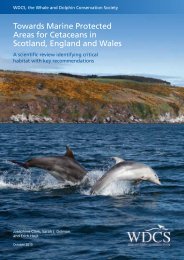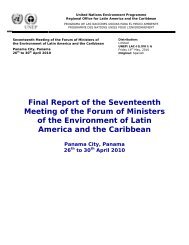Sea Turtle Recovery Action Plan for Barbados - WIDECAST
Sea Turtle Recovery Action Plan for Barbados - WIDECAST
Sea Turtle Recovery Action Plan for Barbados - WIDECAST
You also want an ePaper? Increase the reach of your titles
YUMPU automatically turns print PDFs into web optimized ePapers that Google loves.
<strong>Barbados</strong> <strong>Sea</strong> <strong>Turtle</strong>s …<br />
Persons wishing to export turtle shells or shell products from <strong>Barbados</strong> require documentation<br />
from the Ministry of Trade, Industry, and Commerce (<strong>Barbados</strong> Export Promotion<br />
Corporation) and from the Ministry of Labour, Consumer Affairs and the Environment (Price<br />
Control Division). Permission from the Chief Fisheries Officer is also required. Present policy<br />
does not permit the exportation of turtle shells that originate in <strong>Barbados</strong>. Japanese Customs<br />
data indicate that 1,930 kg of "bekko" (hawksbill shell scutes) was imported from <strong>Barbados</strong><br />
between 1970-1986 (Milliken and Tokunaga, 1987), and that a further 529 kg was imported in<br />
1990 (Canin, 1991). It is unlikely that the population of hawksbills around <strong>Barbados</strong> could<br />
supply this amount of bekko and the data suggest that <strong>Barbados</strong>, a non-party to CITES<br />
[Convention on International Trade in Endangered Species], has been named as the port of<br />
export even though the shell did not actually originate from <strong>Barbados</strong>. This practice is not<br />
uncommon among dealers trying to evade CITES restrictions (Canin, 1991).<br />
The lateral and vertebral scutes from the carapaces of two adult hawksbills caught in<br />
<strong>Barbados</strong> (82 cm and 95.5 cm curved carapace length) yielded an average of 1.4 kg bekko (J.<br />
Horrocks, unpubl. data). This agrees with the calculated average yield of 1.34 kg bekko per<br />
hawksbill imported into Japan from the Caribbean region (Milliken and Tokunaga, 1987). Based<br />
on the Japanese Customs statistics cited above and the average yield of bekko per hawksbill, we<br />
can estimate that 1,440 turtles were killed between 1970 and 1986, and nearly 400 more in 1990,<br />
in order to supply the bekko exported (or allegedly exported) from <strong>Barbados</strong> to Japan.<br />
3.4 Inadequate Regulatory Mechanisms<br />
It is illegal to take turtle eggs, to catch or attempt to catch turtles on the beach or within<br />
100 yd (90 m) of the shore, or to buy, sell or possess any turtle of weight less than 30 lbs (13.6<br />
kg) (section 4.21). If found guilty, offenders are punishable by confiscation of the turtle, eggs,<br />
and/or fishing gear and by a fine of Bds. $100 (US $50). The present legislation offers little<br />
deterrent since an "average" female is worth between Bds. $200-300 in meat alone (section 3.3).<br />
Confiscation of gear, such as boats, is a more serious deterrent, but since catching a female on<br />
the beach requires no gear that can be confiscated, the fine of Bds. $100 is totally insufficient to<br />
deter the widespread poaching of nesting females. Recognizing that present legislation is<br />
inadequate, new regulations are proposed in section 4.23. Improving local en<strong>for</strong>cement ef<strong>for</strong>ts is<br />
discussed in sections 4.22 and 4.616.<br />
3.5 Other Natural or Man-made Factors<br />
Four additional sources of mortality should be mentioned. First, the illegal practice of<br />
dynamiting coral reefs <strong>for</strong> fish (section 4.141) kills an unknown number of turtles each year.<br />
Second, there are increasing reports of turtles being struck by speed boats and jet skis in the<br />
waters off the west and south coasts. Third, compaction of sand over nests, caused by heavy<br />
pedestrian beach use, prevents the emergence of hatchlings, and has caused up to 100% mortality<br />
in some nests (Horrocks and Scott, 1991). Fourth, nest flooding by salt and freshwater is a<br />
serious threat to the successful hatching of eggs in some areas (Horrocks and Willoughby, 1987).<br />
All sea turtle embryos require oxygen during their development and will drown if submerged in<br />
water <strong>for</strong> an extended period of time.<br />
Page 9

















